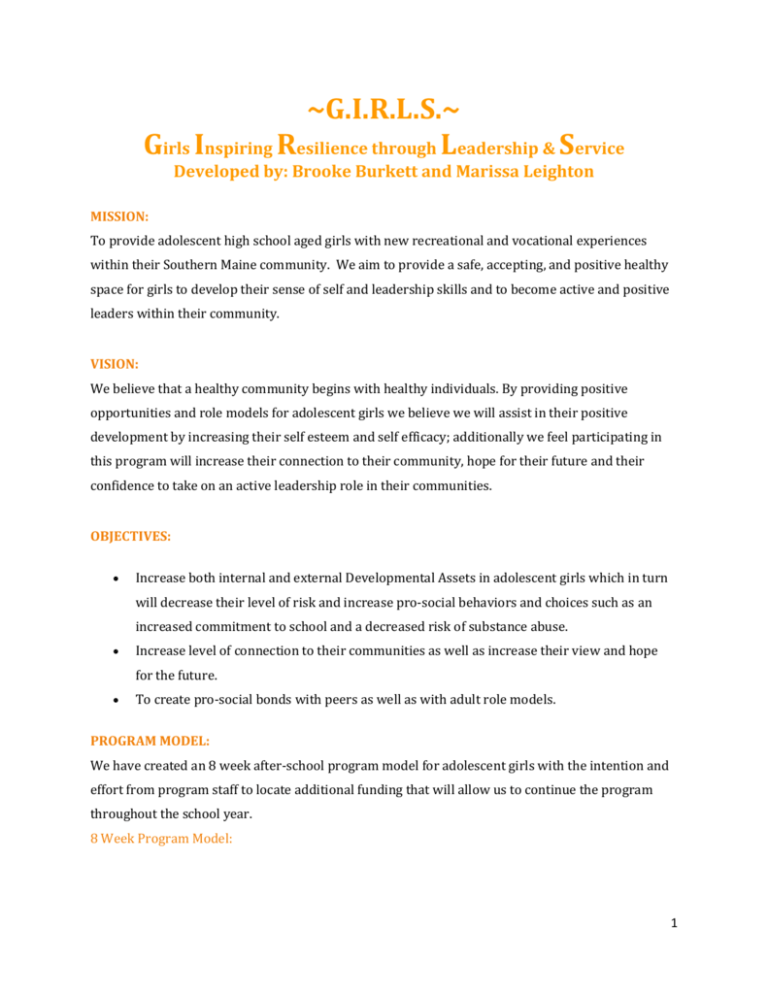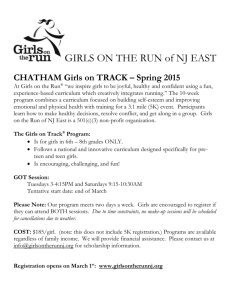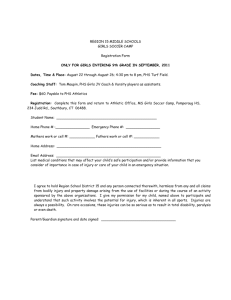link to Word Doc
advertisement

~G.I.R.L.S.~ Girls Inspiring Resilience through Leadership & Service Developed by: Brooke Burkett and Marissa Leighton MISSION: To provide adolescent high school aged girls with new recreational and vocational experiences within their Southern Maine community. We aim to provide a safe, accepting, and positive healthy space for girls to develop their sense of self and leadership skills and to become active and positive leaders within their community. VISION: We believe that a healthy community begins with healthy individuals. By providing positive opportunities and role models for adolescent girls we believe we will assist in their positive development by increasing their self esteem and self efficacy; additionally we feel participating in this program will increase their connection to their community, hope for their future and their confidence to take on an active leadership role in their communities. OBJECTIVES: Increase both internal and external Developmental Assets in adolescent girls which in turn will decrease their level of risk and increase pro-social behaviors and choices such as an increased commitment to school and a decreased risk of substance abuse. Increase level of connection to their communities as well as increase their view and hope for the future. To create pro-social bonds with peers as well as with adult role models. PROGRAM MODEL: We have created an 8 week after-school program model for adolescent girls with the intention and effort from program staff to locate additional funding that will allow us to continue the program throughout the school year. 8 Week Program Model: 1 Weekly After-school program for 10 adolescent high school aged girls on Monday afternoons from 2:15-5:30 for 8 weeks. Transportation to and from the program activities will be provided. In each session the girls will participate in a variety of pro-social group activities, on site at Camp Ketcha as well as off site to various community locations. The activities will include: o Introduction to various seasonal outdoor adventure activities which could include ropes course programming, mountain biking, rock climbing and rappelling, hiking, horsemanship and riding, basic wilderness survival skills, cross country skiing, snowshoeing, gardening, kayaking, etc. o Community service projects and workshops with women in the community chosen based on vocational and recreational interests of the girls in the group. Program staff will connect with women in the community who would be open to leading a project or workshop for our group. o Schedule of activities will be co-created with the group. Fall Retreat: Celebration and reflection of our time together. Will be determined with the group. Program Model for school year: If funding was available to run the program throughout the school year the model would be the following: 1 Community Project per month: o Generate a list of vocational, recreational interests of the girls in the program as well as local causes they are interested in supporting. Seek out women in the community who are in these professions to connect with so the group can take part in a service project, or workshop to provide a deeper understanding of their interests and passions. o Plan and work on fundraising project decided on by girls to raise money for our program as well as another program or cause the group has chosen to support. 1 Adventure Activity/Outing per month: 2 o Utilize Camp Ketcha resources (rock climbing, rappelling, mountain biking, ropes course, gardening, hiking, basic wilderness survival skills, cross country skiing, snow shoeing, horseback riding, etc) to introduce girls to new experiences that will provide opportunities for self reflection and cultivation, foster self esteem through succeeding and persevering through challenges, and foster positive group dynamics. 2 After-school Group Check-in per month: Time to focus on group dynamics, address issues, generate ideas, etc. Introduce ideas, resources, skills and topics important to the developmental needs of the group such as effective communication, controlling emotions, decision making, conflict resolution techniques, anger management, healthy lifestyle choices for mind, body and spirit, community resources and activities available, etc. Fall and Spring Retreats: Celebration and reflection of our time together. Will be determined with the group. ADDITIONAL PROGRAM IDEAS: Peer Leader Interns- 2 spots will be available for girls who have completed the program to apply for to become peer leaders for the group the following year. We hope to find funding to make these paid positions. G.I.R.L.S. Advisory Committee- made up of women leaders throughout the community as well as youth committee members. Choose a fundraising project that the group will focus on for the year which raises money for our program as well as another non-profit or organization the girls choose to support. Potentially enhance the Fall and Spring retreat to be an open forum for other girl’s leadership programs to attend. 3 SUPPORTING RESEARCH: Gender differences have been consistently observed with respect to internalizing and externalizing behavior problems with girls reporting more internalizing problems, especially depression, and boys reporting more externalizing problems, especially aggression and delinquency (Graber, 2004; Farrington, 2004; Beam et al., 2002; Leadbeater et al., 1999; NolenHoeksema & Girgus, 1994; Newman, Lohman, Newman 2007). Additionally, current research consistently shows that adolescent girls tend to be more vulnerable than boys through their adolescence and typically it is a time for self esteem to decrease, which increases a young women’s risk of tending towards high risk behaviors, (Carruthers 2006). In a recent study focused on three aspects of peer group membership in adolescence: peer group affiliation, the importance of group membership, and a sense of peer group belonging girls also reported a higher sense of peer group belonging than boys indicating a higher need to be involved in peer groups, (Newman, Lohman, Newman 2007). Adolescents who viewed peer group membership as very important to them and had a positive sense of peer group belonging had significantly fewer behavior problems than those who viewed peer group membership as very important but did not have a positive sense of peer group belonging, (Newman, Lohman, Newman 2007). Involvement in youth after-school recreation programs is associated with thriving behaviors, including leadership, helping others, maintaining health, and overcoming adversity, (Carruthers 2006). Although peer group membership may be associated with some behavior problems, it is contended that the lack of a sense of peer group belonging places adolescents at greater risk for both internalizing and externalizing problems than does peer group membership (Newman, Lohman, Newman 2007). This is because of the central role of a sense of group belonging for sustaining well-being in the expanding social world of adolescence and the especially unique sensitivity to social exclusion that characterizes this period of life, (Newman, Lohman, Newman 2007). Research has found that youth who participated in high-quality youth programs acquired greater initiative, motivation, social capital, multicultural awareness and competence, sense of responsibility, and increased civic engagement, (Carruthers 2006). Effective afterschool programming is congruence with the principles of the Resiliency Model, based on research which focuses on fostering the internal and external “protective factors” that allow individuals to that allow for individuals succeed through adversity. The 6 environmental protective factors that have been found to foster and enhance an individual’s level of resiliency are: 1. Provide Caring and Support, 2. Set and Communicate High Expectations, 3. Provide Opportunities 4 for Meaningful Involvement, 4. Increase Pro Social Bonding, 5. Set Clear, Consistent Boundaries; 6. Teach Life Skills, (Henderson [Ed], 2008). Engaging disenfranchised youth in programming that embraces the protective factors have been shown to assist individuals in the development of their innate resiliency which allows for them to “successfully adapt in the face of adversity and develop social, academic and vocational competence despite exposure to severe stress or simply to the stress that is inherent in today’s world. Carruthers’ research also found that “successful after-school programs provide youth with opportunities to develop physical, intellectual, psychological and social skills, and competencies. Effective after school programs increased thriving behaviors such as grades, academic expectations, graduation rates, and post-secondary training or education, feelings of safety, communication with family and peers, and risk avoidance (Carruthers 2006). The Search Institute basis of youth development asserts through surveying a wide range of adolescents, that teens who report high levels of connection in the areas of relationships, opportunities & supports flourish on every academic, psychological, social-emotional, and behavioral outcome they studied. Yet, they have also found that too few teens experience them. The result is that nine out of ten American 15-year-olds don’t have enough positive experiences and relationships upon which to build their lives, and only 7 percent of the 15-year-olds surveyed experience high levels of all three strengths; extrapolating upon these findings means that about 3.9 million 15-year-olds in America don’t receive the relationships, opportunities, and supports they need to grow up well (Search Institute 2010). Carruthers promotes that effective after-school programming, especially “girls only” groups, have been found to increase a young woman’s sense of self, and ability to recognize their power and their “own voice”, (Carruthers 2006). In summation, leading professionals assert that after -school programming for young women should focus on “the unique developmental needs of girls related to self-efficacy and empowerment and provide opportunities for decision-making and choice, affirmation, relationship building, and skill development,” (Carruthers 2006). SOURCES: Carruthers, C., (2006) Processes and Outcomes of an After-School Program for Adolescent Journal of Park & Recreation Administration. Vol. 24 Issue 4, p127-152. Girls. Henderson, N [Ed.], (2007). Resiliency In Action; Practical Ideas for Overcoming Risks and Building Strengths in Youth, Families, and Communities. Resiliency in Action, Inc.; Ojai, CA. Henderson, N. & Milstein, M., (2003). Resiliency in Schools; Making it Happen for Students and Educators. Corwin Press, Inc.; Thousand Oaks, CA. 5 Freyberg R., (2009). Quantitative and Qualitative Measures of Behavior in Adolescent Girls. Adolescence. Vol. 44 (173). Pg. 33-54. Newman B.,Lohman, B., Newman, P.(2007). Peer Group Membership and a Sense of Belonging: Their Relationship to Adolescent Behavior Porblems. Adolescence. Vol. 42, (166). Pg. 241-263 Olson, J. (July 19th 2010). Teens Lack Adult Shoulder to Lean On/ Study Finds. Star Tribune (Minneapolis). Retrieved from: <http://www.newsobserver.com/2010/07/19/588053/teenslack-adult-shoulder-to-lean.html7/26/10> Steese S., Dollette M., Phillips W., Hossfeld E, (2006) Understanding Girls’ Circle as an Intervention on Social Support, Body Image, Self Efficacy, Locus of Control, and Self Esteem. Adolescence. Vol. 41 (161). Pg. 55-74 Teen Voice 2010. Study done by Search Iinstitute and Best BuyChildren Institute. Retrieved from http://www.search-institute.org July 26, 2010. Vieno A., Kiesner J., Massimiliano Pastore M., Santinello, M., (2008). Antisocial Behavior and Depressive Symptoms: Longitudinal and Concurrent Relations. Adolescence. Vol. 43, (171). Pg. 649660. 6






